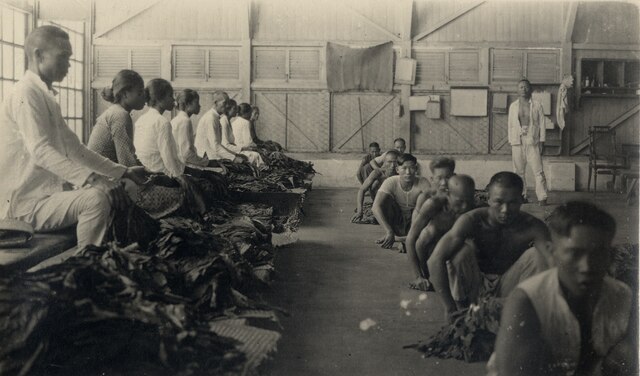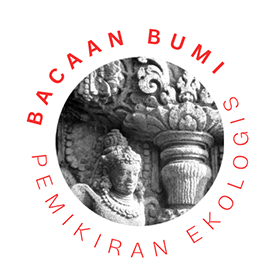Why some ride-hailing drivers stay outside mutual aid organisations
Sheri Lynn Gibbings, Elan Lazuardi and Robbie Peters
While many journalists and academics reported the atomisation of ride-hailing drivers in North America and Europe, Indonesia seemed to be a good news story. There, drivers for Gojek, Grab and Shopee were forming tight-knit mutual aid organisations. During the first few years of our fieldwork, we met many drivers who belonged to mutual aid groups. Tika and her husband both work as online motorcycle taxis drivers in Bandung while their elementary school-age children are cared for at the basecamp, where drivers from their community usually hang around, waiting for orders or helping each other out. Tika calls this ‘kerja bawa anak’ (working while bringing your children).
For people familiar with the history of social relations in Indonesia, the appearance of these mutual aid organisations is not surprising. Mutual aid societies have operated in Indonesia since colonial times and are found in neighbourhoods, factories, among street vendors, and in almost every workplace. Mutual aid networks played an important role in helping neighbourhood residents during the depression and allowed people in poor neighbourhoods to mobilise labour and resources during the Suharto era, according to John Ingelson. They continue to provide an indispensable safety net, and as a result, shortly after online motorbike taxis emerged, drivers started to set up their own mutual aid organisations to provide advice to new drivers and support in case of accidents, sickness and death.
Over time, however, as we gathered more fieldwork data, we started to understand that driver relationships to mutual aid organisations were complex and fluid. We found many drivers who operated outside of or on the edge of mutual aid networks. There was even a name for these people: ‘single fighters’, an English term. The term suggests a person who makes it on their own without recourse to a mutual aid organisation, but in practice, they were more complex figures, who moved in and out of these organisations by staying on what we call their ‘edge’.
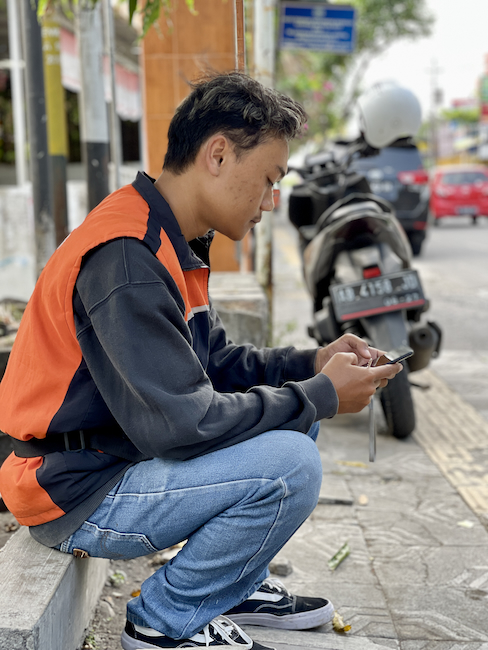
Drivers might join a mutual aid organisation and then leave it a few months later. They might remain friendly to those in them, but not participate as members. The reasons were many. Single fighters were sometimes new entrants to ride-hailing and had yet to find a group they felt comfortable joining. Others had families or other time-consuming activities. Others joined a driver community when they saw the benefits but left after feeling the obligations were too much. Some drivers found other ways to get information, turning to Facebook, WhatsApp or friend networks. These drivers might operate on the edge of driver mutual aid organisations but be more engaged in other communities, based on neighbourhood, religious or political affiliations.
Yanti was one such single fighter. She was a 47-year-old driver from Surabaya who kept herself out of the driver organisations because, she said, she was often hit on by men. She networked with other drivers through a WhatsApp group but did not officially belong to any organisations. She complained that unmarried female drivers were prone to ‘be the target of male drivers’ wives’ anger’. Additionally, Yanti believes being tied to one community decreases your job performance. She explained that it is better to wait actively by staying on the move, rather than staying in one place at a basecamp hanging out.
Over the course of our team’s fieldwork from 2021 to 2024 in Yogyakarta, Bandung and Surabaya, we discovered more and more single-fighter drivers like Yanti and sought to understand what kept them on the edge of driver communities. What were the benefits and risks to them of being on the edge?
Refusal to stop driving: Laskar and exceptional drivers
The ride-hailing applications’ algorithm in Indonesia shifted in 2020 to reward drivers who worked consistently long hours and achieved high customer ratings. This meant that drivers who needed to shut off their application because they had to pick up their children from school or were too sick to work proved unable to move up from a basic account to a higher status silver, gold or platinum account, receiving fewer orders as a result. Those who could work long hours were rewarded with a gold or platinum account and a greater number of orders. Platinum drivers were able to get 20 to 30 orders a day, which meant that they were constantly on the move and did not have much time to gather at basecamps.
Sometimes these drivers who focused on rides rather than community were also called laskar drivers, as well as ‘single fighters’. Eko was one such driver. He was sometimes referred to as Grab’s ‘golden boy’ because he gets 30-40 orders per day, much higher than the daily average of ten orders for an ordinary driver. He describes himself as achieving this through his own order-getting ‘formula’ and by increasing his daily active service hours to 17 hours. As Eko explained, laskar drivers are sometimes difficult to accept for the ordinary drivers who are loyal to a driver community. It is rare to find the laskar drivers at basecamps because being idle is contrary to their formula of being on the move.
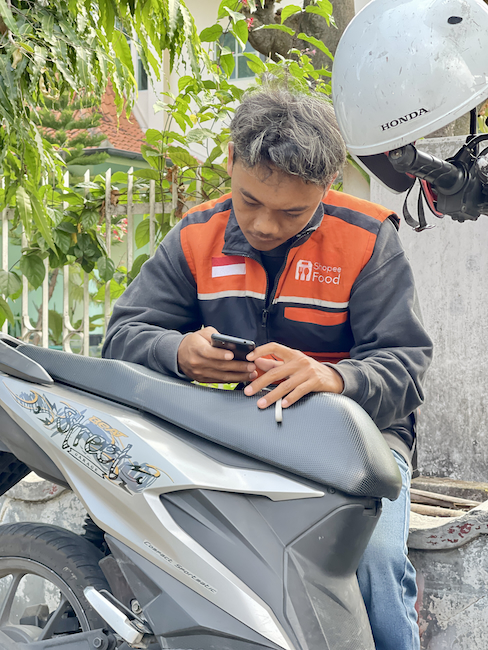
Abdul often starts driving at 6am and drives until two the next morning. He worked about 12 hours for Gojek and 6 hours for Grab, often working 18-hour days. At one point he was doing 46 to 48 orders for Gojek per day. Abdul joined several driver groups when he started driving in November 2015 in order to learn the system, but once he did, he disinvested from these groups. At the start there were turf wars between those drivers who operated on ride-hailing platforms like Gojek and Grab and those who were hailed by people in the street. The former were taking over as the predominant ride-hail form in Indonesia but not without resistance from the latter and Abdul wanted to avoid areas mired in these conflicts. Once he did, he stopped participating in driver organisations. He found these organisations demanded more of his time to attend and help out at members’ weddings or other significant life events and to help out members who were sick, injured or in some sort of trouble. He still, however, benefits from these organisations through a friend who remains a member, and shares information with Abdul. From his viewpoint, he didn’t have time to attend gatherings because he had to reach his target number of daily orders with Gojek in order to get his bonuses. Despite his time disinvestment, he continued to invest small amounts of money intermittently to maintain good social standing among other drivers.
This prioritisation of money over time by laskar drivers was not an outright rejection of mutual aid organisations. Such attitudes maintained loyalty to the organisation through the donation of money rather than time. This refusal to commit time was also a form of identification for laskar that stated they were not like other drivers. This strategy of making it on one’s own was, however, a risky one that left them without the support of other drivers when in need.
Refusing control: avoiding surveillance
Some drivers were single fighters because they felt disconnected from and suspicious of the organisations. An example is Slamet, who was born in 1984 in Jakarta and worked as a security guard there from 2004 to 2012 before moving to Yogyakarta, working security briefly for the Gojek office. Slamet refers to himself as a ‘single fighter’ because he likes to be ‘free’ to float around the different groups. He sees himself as different from other drivers in Yogyakarta. He described how people in Yogyakarta value nrimo or the attitude of accepting things as they are and being grateful to the ride-hailing companies because they are afraid of losing work. Drivers, he said, complain endlessly to each other rather than fighting for their rights. He also felt that the driver organisations could not help their drivers because the leaders were often under the company’s control.
He also doesn’t want to be too involved in any organisation because he learned as a security guard at a Gojek office that it sent spies to infiltrate organisations. For Slamet being a single fighter meant being outside any organisation and thereby less visible to the company and its spies. His name would not appear on any official list of wrong doers and would not be associated with any protests. He was less concerned with making money and consolidating his status as a platinum driver, and more concerned with maintaining the privacy that enabled him to not have to dance to the tune of the platform like the other more ‘accepting’ drivers.
Gendered refusals
For women, participation in driver organisations was complicated by gender politics. Yanti, the 47-year-old widow from Surabaya, did not join a community basecamp because she felt being seen hanging around with many male drivers was a danger to her image as an unmarried woman. When we returned months later, we found she had created another way to be on the edge of driver communities that offered her more protection. When a research assistant visited the basecamp at a local food stall, they found that Yanti’s boyfriend was often there even though he was not a driver, hanging out with her while she waited for an order.
Another female driver who had to find the edges of driver organisations was Siti, a 54-year-old retiree with a bachelor’s degree who had worked for much of her life as a cleaning service supervisor. Siti is married with a working-age daughter at home and husband at work in another city. She viewed driving as a hobby rather than a financial necessity when she started in 2019 and chose to drive for Shoppee because it only delivers food and items rather than people. As a woman, she did not want to carry passengers, especially male passengers, because of both the stigma and dangers of physical proximity with them.
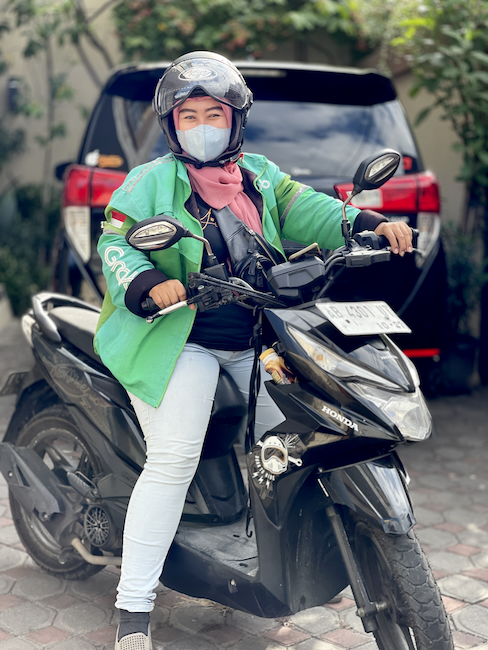
Siti defined a ‘single fighter’ as someone who is not part of any group and does not like to hang around at the side of the road. She is not part of any community herself but often waits in front of her neighbour’s food stall. She doesn’t like hanging out (nongkrong) anywhere else because it makes her embarrassed (malu) as a Javanese woman. She described hanging out in an unfamiliar place with people who do not know each other as nongkrong and suggests it happens these days at places like restaurants where male drivers hang out with more willing female drivers. ‘Personally,’ she said, ‘I don’t have the heart to hang out there.’ At the same time, she follows a Shoppee Food group on Facebook because she can learn about their experience in dealing with customers. By controlling where and who she socialises with, Siti was able to maintain respect in her neighborhood and among drivers, and to claim a higher status in contrast to some other female drivers who socialised with their male counterparts at basecamps.
Although there were women who found ways to be in mutual aid organisations and basecamps, others preferred the single fighter approach of staying on the edges where they could maintain more acceptable social relationships that upheld their status as chaste women devoted to their families. For women like Siti and Yanti, their actions were not an act of outright rejection of association with other drivers, as such, but a subtle navigation of the challenges of association. Some women created a Lady Driver group as a solution, giving them a place to hang out, discuss orders and joke around with each other without having to worry about upsetting social norms. It even helped these women declare their identity as ‘good women’ in the eyes of their neighbours and fellow drivers.
Living on the edge
Drivers were single fighters because it gave them the ability to associate loosely with communities without committing themselves too deeply. Such loose association had its benefits. It suited drivers who wanted to focus on making money for their family, those who wanted to remain illegible to the company and government, and those who wanted to protect their image. Being on the edge of driver communities is a strategic position to take that offers drivers more flexibility, but it risks the stigma among Javanese of being ‘ra tau srawung’, or someone who is not present and remains uninvolved in the daily social life of the community of which they are a member.
The single fighter is becoming more popular now that more drivers are caught in the pull of the application’s algorithm, which prioritises drivers who stay on move in search of customers. However, the single fighter cannot reject the community entirely. As a result, single fighter drivers often remain on the edges of driver communities with the ability to become more involved with them at any moment. From the edges, they can avoid surveillance, protests and member obligations. There are trade-offs, however. They are at risk of losing access to support that mutual aid organisations offer their drivers who are sick, injured or facing legal issues. In a country where the welfare state is expanding but remains weak by Western standards, the welfare of mutual aid organisations remains essential and something single fighters cannot completely disinvest from.
Sheri Lynn Gibbings (sgibbings@wlu.ca) from Wilfrid Laurier is the Principal Investigator and Joshua Barker (j.barker@utoronto.ca) is the co-PI from the University of Toronto. Elan Lazuardi (elan.lazuardi@ugm.ac.id) from Gadjah Mada University has been a key partner in this research and has helped mobilise student research teams to conduct interviews and fieldwork. Robbie Peters (robbie.peters@sydney.edu.au) from the University of Sydney has acted as a collaborator. We thank Andrea Earl for taking photos during the fieldwork. The ‘Ubering the City’ research project funded by the Social Sciences and Humanities Research Council of Canada aims to understand how ride-hailing drivers are relating to each other and the companies during this rapid change to the transportation industry.


